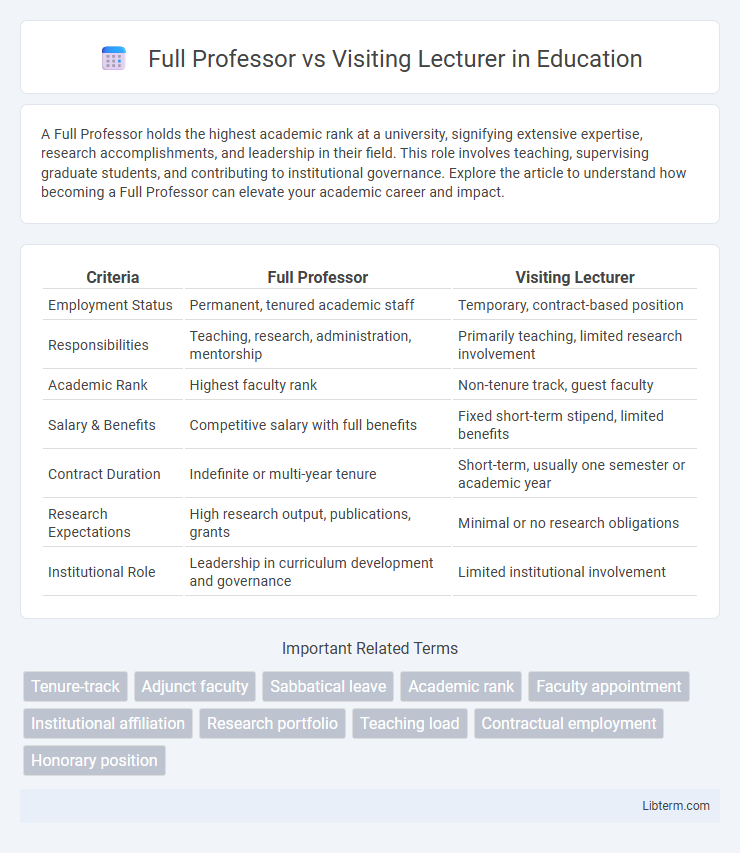A Full Professor holds the highest academic rank at a university, signifying extensive expertise, research accomplishments, and leadership in their field. This role involves teaching, supervising graduate students, and contributing to institutional governance. Explore the article to understand how becoming a Full Professor can elevate your academic career and impact.
Table of Comparison
| Criteria | Full Professor | Visiting Lecturer |
|---|---|---|
| Employment Status | Permanent, tenured academic staff | Temporary, contract-based position |
| Responsibilities | Teaching, research, administration, mentorship | Primarily teaching, limited research involvement |
| Academic Rank | Highest faculty rank | Non-tenure track, guest faculty |
| Salary & Benefits | Competitive salary with full benefits | Fixed short-term stipend, limited benefits |
| Contract Duration | Indefinite or multi-year tenure | Short-term, usually one semester or academic year |
| Research Expectations | High research output, publications, grants | Minimal or no research obligations |
| Institutional Role | Leadership in curriculum development and governance | Limited institutional involvement |
Introduction to Academic Ranks
Full Professor represents the highest academic rank, typically requiring extensive research, teaching experience, and significant contributions to the discipline, while Visiting Lecturer is a temporary position often held by professionals or academics invited for short-term teaching engagements. Academic ranks progress from Assistant Professor to Associate Professor, culminating in Full Professor, each level reflecting increased expertise and institutional responsibility. Visiting Lecturers usually do not hold tenure and focus primarily on delivering specialized courses without long-term commitments or research obligations.
Definition of Full Professor
A Full Professor is a senior academic rank denoting a faculty member with extensive research, teaching experience, and a significant record of scholarly contributions within a university. Unlike Visiting Lecturers, who hold temporary or short-term positions primarily focused on teaching, Full Professors possess tenure or a permanent appointment and often engage in leadership roles, curriculum development, and research supervision. The status of Full Professor reflects a high level of expertise, academic achievement, and institutional commitment in higher education.
Definition of Visiting Lecturer
A Visiting Lecturer is an academic professional invited to teach or conduct research at a university for a limited time, often bringing specialized knowledge or industry experience. Unlike a Full Professor, who holds a permanent, often tenure-track position with extensive research, teaching, and administrative responsibilities, a Visiting Lecturer typically has a fixed-term contract with primary focus on specific courses or projects. The role of Visiting Lecturer enhances academic diversity and supports institutions in delivering specialized curriculum without long-term commitment.
Key Responsibilities and Roles
A Full Professor holds a permanent academic position responsible for conducting advanced research, delivering comprehensive lectures, mentoring graduate students, and participating in university governance and curriculum development. In contrast, a Visiting Lecturer typically engages in teaching specific courses on a temporary basis without extensive research obligations or administrative duties. Full Professors influence institutional policies while Visiting Lecturers primarily focus on instructional delivery and guest expertise.
Qualifications and Experience Required
Full Professors typically require a PhD in their field, extensive research experience, and a strong record of published work, often with over a decade of academic teaching and leadership roles. Visiting Lecturers usually hold at least a master's degree or equivalent professional experience, with a focus on practical expertise or specialized knowledge, often without the need for extensive research credentials. The Full Professor role demands significant academic accomplishments and tenure, whereas Visiting Lecturers provide temporary or part-time instruction based on current industry or academic experience.
Teaching and Research Expectations
Full Professors are expected to lead advanced research projects, publish extensively in peer-reviewed journals, and secure funding while delivering comprehensive teaching across undergraduate and graduate courses. Visiting Lecturers primarily focus on delivering specialized teaching within a fixed term, with limited or no obligation to conduct research or engage in grant applications. The role of Full Professor demands sustained scholarly contributions and mentorship, contrasting with the visiting lecturer's emphasis on instructional expertise and temporary academic service.
Contractual Terms and Job Security
Full Professors typically hold permanent contracts with extensive job security, including tenure or long-term appointments that guarantee academic freedom and stable income. Visiting Lecturers usually work on fixed-term or temporary contracts, often without benefits like pension contributions or guaranteed renewal. This significant difference in contractual terms directly impacts job stability, career progression, and academic responsibilities.
Academic Influence and Career Growth
Full Professors typically hold tenured positions, providing significant academic influence through sustained research output, leadership roles, and mentorship within their institutions. Visiting Lecturers often have limited-term contracts, which can restrict long-term career growth but offer opportunities for expanded networks and diverse teaching experiences across multiple institutions. The trajectory of a Full Professor generally involves greater stability and cumulative impact on academic disciplines compared to the transient role of Visiting Lecturer.
Salary and Benefits Comparison
Full Professors typically receive significantly higher salaries than Visiting Lecturers, reflecting their permanent status and extensive academic experience. Benefits for Full Professors often include comprehensive health insurance, retirement plans, sabbaticals, and research funding, which are rarely extended to Visiting Lecturers due to their temporary contracts. Visiting Lecturers usually receive limited or no benefits and earn adjunct-level pay, which is substantially lower than the full-time, tenure-track salary scales associated with Full Professors.
Choosing Between Full Professor and Visiting Lecturer Paths
Choosing between Full Professor and Visiting Lecturer roles depends on long-term career goals and institutional commitment. Full Professors focus on permanent academic positions with extensive research, teaching, and administrative responsibilities, while Visiting Lecturers typically engage in short-term contracts with a primary emphasis on teaching and flexible schedules. Evaluating factors such as job security, research opportunities, and work-life balance is crucial for making an informed decision between these academic paths.
Full Professor Infographic

 libterm.com
libterm.com